Ardee
Ardee (/ˈɑːr.diː/ – Irish: Baile Átha Fhirdhia – pronounced [ˈbˠalʲə aːhə fʲerðiað]) is a town and townland in County Louth, Ireland. It is located at the intersection of the N2, N52, and N33 roads. The town shows evidence of development from the thirteenth century onward but as a result the continued development of the town since then much of the fabric of the medieval town has been removed.[2]
Ardee
Baile Átha Fhirdhia | |
|---|---|
Town | |
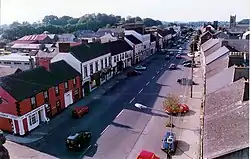 View north along Market Street, from the battlements of Ardee Castle | |
 Coat of arms | |
| Motto(s): Na Bris Sith, Na Bris Cairdis Don't Break Peace, Don't Break Friendship | |
 Ardee Location in Ireland | |
| Coordinates: 53.855362°N 6.537895°W | |
| Country | Ireland |
| Province | Leinster |
| County | County Louth |
| Dáil Éireann | Louth |
| EU Parliament | Midlands–North-West |
| Population (2016)[1] | |
| • Urban | 4,928 |
| Time zone | UTC±0 (WET) |
| • Summer (DST) | UTC+1 (IST) |
| Eircode routing key | A92 |
| Telephone area code | +353(0)41 |
| Irish Grid Reference | N958906 |
Ardee is on the banks of the River Dee and is equidistant between the county's two biggest towns - approximately 20 km (12 mi) from Dundalk and Drogheda, while it is also close to Slane and Carrickmacross.
In the 20 years between the 1996 and 2016 census, the population of Ardee increased by approximately 30%, from 3,791 to 4,928 inhabitants.[1][3]
History
Origins
Originally called Atherdee, the towns name is from Irish: Áth Fhirdia (the Ford of Ferdia) which itself is derived from the fabled four-day battle between Cúchulainn and Ferdia, for the defense of Ulster from Queen Maeve of Connacht. It is said Ferdia fell after four days of battle, and is buried on the southern banks of the river alongside the Riverside Walk. A depiction of the pair is located on Bridge Street in the town as a bronze statue.[2][4]
Ardee is an example of a medieval "walled town", a number of which can be found across Ireland. The town itself is situated in the southern part of the ancient territory known as the Plain of Muirheimhne. The town lies along the 15th century Pale frontier between Dundalk and Kells.
The town comprises the townlands or townparks – the greater portion of which is made up of Ardee bog, and a small portion of Dawson's Demesne, which takes in the southeastern quadrant of the town on the northern side of the River Dee.
Smith schools
A philanthropic trust founded by Erasmus Smith in the 17th century funded the establishment of a boys' school in 1806 and a girls' school in 1817. Both Protestant and Catholic children were allowed to attend. At the time there were other schools but in 1824 they became the sole schools in the area. The Smith schools amalgamated into a combined-sex establishment by 1858, by which time the National School movement was leading to the creation of denominational schools there. The school remained a non-denominational institute but the school decreased in numbers and in 1868 had a roll of only 16 Protestant boys. It was fully integrated into the National School system in 1954, when it became known as Saint Mary's Church of Ireland National School.[5]
Administration
Ardee lies in the local council area of Louth County Council. Members of the council are elected from five electoral areas in the county. Ardee lies in the Ardee electoral area, which returns six of the council's 29 members.[6][7]
Ardee is in the Roman Catholic parish of Ardee & Collon which lies in the Archdiocese of Armagh in the ecclesiastical province of Armagh.[8][9]
Media
Newspapers include the Mid-Louth Independent, a regional edition of the Drogheda Independent newspaper, which is published weekly. It is distributed and sold in Ardee, Collon, Dunleer and Tallanstown. The Dundalk Democrat is the regional edition of the weekly newspaper, which covers Ardee and its surrounds.[10]
LMFM Radio is the local radio station for the North East covering Ardee as well as the rest of Louth, Meath, Monaghan and North Dublin.
Transport
Ardee Railway station, previously serving the town, was linked to the main Belfast-Dublin railway line at Dromin Junction station, along a five mile long (8 km) branch line.
The Ardee Railway station opened on 1 August, 1896 and passenger services ended on 3 June, 1934. The line continued as a freight service until finally closed on 3 November, 1976,[11] serving the local fertiliser factory, sugar beet and livestock transport.
The trackbed was lifted in the late 1980s, and much of the short route is now a designated walkway. Ardee's transport network consists of the N2, which runs directly through the town, and the M1 motorway, which is connected to Ardee through a bypass/linkroad.
Culture
Ardee Castle

Ardee's identity of a walled town is further enhanced by surviving medieval buildings and some of the features that survive within the town, including the intact medieval street pattern and the castle itself. Previously known as St. Leger's Castle, Ardee Castle is the largest fortified medieval tower house in Ireland.[12] Built circa 15th century, the castle was used as a prison during the 17th and 18th centuries, before going on to become Ardee's district courthouse until June 2006 when a specialised facility was built as it "could no longer meet the official needs of court users in the 21st century".[13]
Chantry College
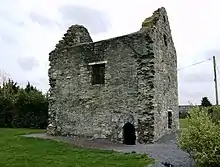
Founded a short time prior to 1487, "Chantry College" consists of a gabled tower, four storeys in height, which has an adjoining two-storey hall to the north. Although the structure was defensible, it is not classified as a fortified town house. It was an ecclesiastical building, and as such differs from the two castles in the town. The small section of the original building shares similarities to another surviving building in Howth, Dublin.[14]
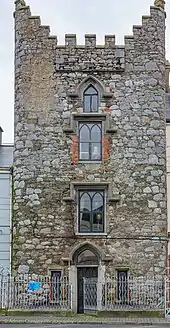
Hatch's Castle
A gift given to the Hatch family by Oliver Cromwell, Hatch's Castle is still in use as a private family home and as a bed and breakfast. A late 14th century urban fortified house, it is the older of the town's two castles. It was modernised in the 19th century with large windows placed in the east and west faces. The southern corner has a projecting turret which houses a spiral stairway to roof level.[15][16]
Jumping Church of Kildemock

The Jumping Church of Kildemock (also known as Millockstown Church) is a tourist attraction in Ardee which claims to be an "unsolved mystery". The site was restored in 1954 after the site was cleared of debris by archaeologists the previous year. Legend surrounding the church states that a non-Christian was believed to be buried inside the church walls in 1715, and that the church "jumped" later that night to leave his remains outside of the sacred grounds.[17]
A plaque on the site reads:
"Is léir ar an bhfalla seo gur aisbrigh sé tuairm 3 troithe isteach óna bhonn. Tá trácht i gcúntais i 1715 ar stoirm mhór sa bhliain sin o'ardaigh an falla as a ionad ach do reir seanchais na ndaoine is amhlaidh a léim an falla isteach thar uaigh dhuine a cuireadh faoi choinneallbhádh."
and is accompanied by a translation in English:
"This wall by its pitch, tilt and position can be seen to have moved three feet from its foundation. Contemporary accounts mention a severe storm in 1715 when the wall was lifted and deposited as it now stands but local tradition states that the wall jumped inwards to exclude the grave of an excommunicated person."
All that remains at Kildemock today is a small ruin, containing the wall that for a reason unknown moved three feet. It is believed to be caused by a storm but this cannot be confirmed.[18]
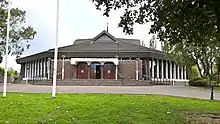
Nativity of our Lady Church
The church is a detached multi-bay Roman Catholic church, built 1974. The church replaced a previously existing Catholic church built 1829, which is now a furniture store.[19]
It is a post-Vatican II church, designed by Guy Moloney and Associates. The leaded light clerestory windows introduce colour to what is otherwise a plain interior.[20][21]
Saint Mary's Church
Built in the early 19th century on the site of an earlier church, St Mary's Church was substantially repaired and rebuilt preserving portions of a tower belong to a previous church. This site has been the focus of Christian worship for at least eight hundred years.[22]
Arts and festivals

Founded in 1860, Ardee Concert Band is the third oldest concert band in Ireland.[23]
Ardee has an annual St Patrick's Parade on March 17. The first parade began in Ardee in 1962 and has run almost every year since then, exceptions include 2001's cancelation due to the foot-and-mouth crisis, 2020's cancellation due to COVID-19.[24][25]
Since 2004, the town has hosted the Ardee Baroque Festival, which includes performances by the Irish Baroque Orchestra and others.
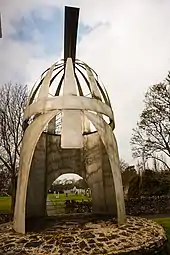
The "Turfman Festival", launched in Ardee in 2009, was held on the August bank holiday weekend and included a number of community events and a Festival Queen competition. The festival was last held in 2013.
In 2017, Ardee hosted the Association of Irish Floral Artists National Flower Festival.
Education
Ardee today has only one secondary school called Ardee Community School. The school opened in 1974 and in 2014 celebrated its 40th year. The school was an amalgamation of three schools that had previously existed independently; St. Anne's Convent of Mercy, De La Salle Brothers’ School and the Vocational School. As of 2019, the school had a student body of around 890.[26] Alumni include MEP Mairead McGuinness, Irish Independent soccer correspondent Daniel McDonnell and The Irish Times political reporter Sarah Bardon.
There are three primary schools located in the town: Monastery Boys National School, Scoil Mhuire na Trocaire Girls School and Ardee Educate Together. Ardee Educate Together is a multi-cultural primary school for both girls and boys. Ballapousta National School is located just outside the town and (as of early 2020) had approximately 220 pupils.[27] As of 2014, the Monastery Boys National School had approximately 250 pupils enrolled,[28] while the Scoil Mhuire na Trocaire Girls School and the Educate Together School had 290 and 150 pupils respectively as of early 2020.[29][30]
Sport
Association football
Ardee is home to two association football (soccer) clubs that play in the North East Football League (formerly MDL) - Square United and Ardee Celtic. Both teams have junior sections that cater for very young players up to Under-18 level.
Athletics
Ardee and District Athletic Club are based in Ardee and was founded in 1992, originally named Ferdia A.C. after the original athletics club in the 1950s but was changed in 2000 to Ardee and District Athletic Club. [31]
Cycling
Ardee Cycling Club was formed in 2010, the club provides a social/leisure group and elite/advanced group for the town. The club also engages in charity cycles.[32]
GAA
Ardee St Marys are the main GAA team in Ardee. The club, known as "the Blues", have had 11 Senior Championship wins in their history - the first in 1914 and the most recent in 1995. St Marys reached the 2016 Louth Senior Football Final for the first time since 2003, being defeated by Sean O'Mahonys of Dundalk on a scoreline of 1-11 to 1-9.[33]
There are five other GAA sides that operate in Ardee's hinterland - Hunterstown Rovers, Westerns GFC, John Mitchels, Sean McDermotts and Stabannon Parnells. Hunterstown Rovers are twice Louth Intermediate Championships and were founded in 1941, they have won the Louth Junior Football Championship four times, most recently in 2013.
Rugby
The town has one rugby club, Ardee Rugby Club, which has a first and second senior team and a number of juvenile teams at various age levels for boys and girls. In 2015, Ardee Rugby Club won the McGee Cup and their youth sides picked up both the Under 15 and Under 17 North East Shield.
Twin town
 Nettuno, Italy
Nettuno, Italy
People
- Ross Gaynor, association footballer[34]
- Mairead McGuinness, politician
- Dermot O'Brien, céilí and showband musician[35]
- Fergal Reilly, film maker[36]
References
| Wikivoyage has a travel guide for Ardee. |
| Wikimedia Commons has media related to Ardee. |
- "Sapmap Area - Settlements - Ardee". Census 2016. CSO. 2016. Archived from the original on 12 January 2018. Retrieved 12 January 2018.
- "Where Ferdia fell: Ardee, Co Louth" (PDF). Archaeology Ireland Heritage Guide. 73: 6. Summer 2016.
- "Ardee (Ireland) Agglomeration". citypopulation.de. Retrieved 16 September 2020.
- Ross. Noel (2011). "The Walled Town of Ardee: Selected Extracts." Journal of the County Louth Archaeological and Historical Society, 27 339-365. - via JSTOR
- Quane, Michael (1969). "The Erasmus Smith School, Ardee". Journal of the County Louth Archaeological Society. 17 (1): 10–18. doi:10.2307/27729188. JSTOR 27729188.
- "Membership of the Louth County Council". www.louthcoco.ie. Retrieved 25 June 2019.
- "Municipal District of Ardee". www.louthcoco.ie. Retrieved 25 June 2019.
- "Catholicchurch | Cappocksgreen | Ardeecollonparish". Catholicchurch | Cappocksgreen | Ardeecollonparish. Retrieved 25 June 2019.
- Pryde, E. B.; Greenway, D. E.; Porter, S.; Roy, I. (1986). Handbook of Britist Chronology. Cambridge University Press. pp. 415–416. ISBN 9780521563505.
- "About The Dundalk Democrat". Dundalk Democrat. Retrieved 30 July 2018.
- "Ardee station" (PDF). Railscot - Irish Railways. Archived (PDF) from the original on 26 September 2007. Retrieved 8 September 2007.
- "The largest fortified medieval tower house in Ireland on the edge of The Pale". Curious Ireland. 2015.
- "New €2.3m courthouse opens in Ardee". The Courts Service of Ireland. 6 June 2006.
- Murtagh, Ben (1989). "Journal of the County Louth Archaeological and Historical Society". County Louth Archaeological and History Society. 22 (1): 16–19. JSTOR 27729670.
- McCormack, W. J. (2003). The Silence of Barbara Synge. Manchester University Press. pp. 27–28. ISBN 9780719062780.
- "1600c – Hatch's Castle, Ardee, Co. Louth". Archiseek - Irish Architecture. Irish Georgian Society. 6 January 2010. Archived from the original on 27 March 2016. Retrieved 13 October 2019.
- Ross, Noel (1983). "The Historical Writings of Diarmuid Mac Íomhair". Journal of the County Louth Archaeological and Historical Society. 20 (3): 175–179. doi:10.2307/27729563. JSTOR 27729563.
- Murtagh, Michael (2005). Kildemock and its Jumping Church.
- "Former Catholic Church, Ardee, Co. Louth". Archiseek. 2010.
- "The Church of the Nativity of Our Lady, John Street, Ardee, County Louth: Buildings of Ireland: National Inventory of Architectural Heritage". www.buildingsofireland.ie. Retrieved 25 June 2019.
- Ruddy, Tom Joe; Magennis, Seamus (1980). The Church of the Nativity of Our Lady, Ardee. Ardee Parish Council.
- "1814 – Old St. Marys Church of Ireland, Ardee, Co. Louth". Archiseek - Irish Architecture. Irish Georgian Society. 6 January 2010. Retrieved 13 October 2019.
- "History". Ardee Concert Band. Retrieved 11 July 2020.
- "Irish St Patrick's Day parades off over coronavirus". BBC News. 9 March 2020. Retrieved 11 July 2020.
- Landy, Barry (9 March 2020). "No parades in 2020 as St Patrick's Day hit by Covid-19 fears". LouthNow.ie. Retrieved 11 July 2020.
- "Department of Education and Skills - Subject Inspection Report - Ardee Community School" (PDF). education.ie. Department of Education. 9 May 2019. Retrieved 6 February 2020.
- "Find a School - Baile An Phusta N S". education.ie. Department of Education. Archived from the original on 6 February 2020.
- "Department of Education and Skills - Whole School Evaluation - Ardee Monastery National School" (PDF). education.ie. Department of Education. 29 January 2014. Retrieved 6 February 2020.
- "School Detail: S N Muire Na Trocaire - Department of Education and Skills". education.ie. Retrieved 6 February 2020.
- "School Detail: Ardee Educate Together N.S - Department of Education and Skills". education.ie. Retrieved 6 February 2020.
- "About Us – Ardee & District A.C." Retrieved 11 July 2020.
- "Ardee Cycling Club - History". ardeecc.club. Retrieved 11 July 2020.
- "County Finals round-up". www.gaa.ie. 2 October 2016. Retrieved 13 October 2019.
- "Former Dundalk star Ross Gaynor enjoying 'fantastic time in my life' after early retirement". dundalkdemocrat.ie. Dundalk Democrat. 5 May 2020. Retrieved 23 November 2020.
- "Obituaries - Dermot O'Brien". independent.ie. Independent News & Media. 27 May 2007. Retrieved 23 November 2020.
- "We're not in Ardee any more: meet the Irish director of the Angry Birds Movie". irishtimes.com. Irish Times. 5 May 2016. Retrieved 23 November 2020.
